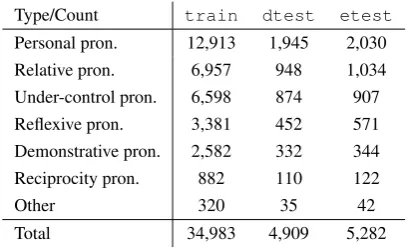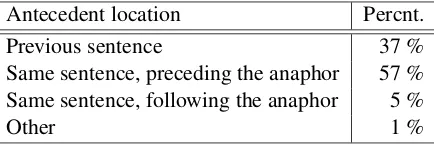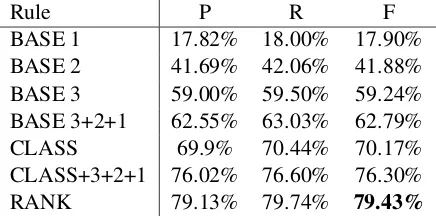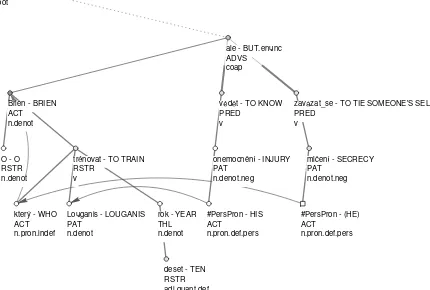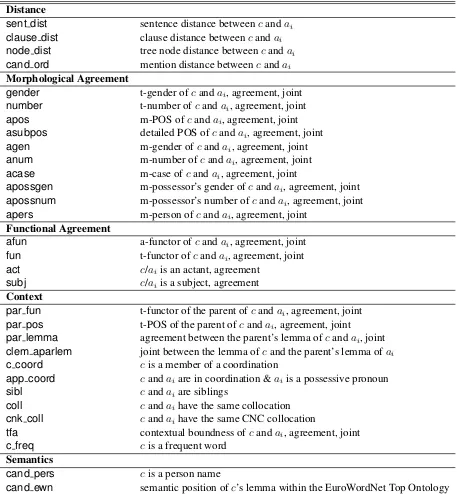Comparison of Classification and Ranking Approaches
to Pronominal Anaphora Resolution in Czech
∗Ngu.y Giang Linh, V´aclav Nov´ak, Zdenˇek ˇZabokrtsk´y
Charles University in Prague
Institute of Formal and Applied Linguistics Malostransk´e n´amˇest´ı 25, CZ-11800
{linh,novak,zabokrtsky}.ufal.mff.cuni.cz
Abstract
In this paper we compare two Ma-chine Learning approaches to the task of pronominal anaphora resolution: a conventional classification system based on C5.0 decision trees, and a novel perceptron-based ranker. We use coref-erence links annotated in the Prague De-pendency Treebank 2.0 for training and evaluation purposes. The perceptron sys-tem achieves f-score 79.43% on recogniz-ing coreference of personal and possessive pronouns, which clearly outperforms the classifier and which is the best result re-ported on this data set so far.
1 Introduction
Anaphora Resolution (AR) is a well established task in Natural Language Processing (Mitkov, 2002). Classification techniques (e.g., single can-didate model aimed at answering: “Is there a coreference link between the anaphor and this antecedent candidate, or not?”) are very often used for the task, e.g. in Mccarthy and Lehnert (1995) and Soon et al. (2001). However, as ar-gued already in Yang et al. (2003), better results are achieved when the candidates can compete in a pairwise fashion. It can be explained by the fact that in this approach (called twin-candidate model), more information is available for the de-cision making. If we proceed further along this direction, we come to the ranking approach de-scribed in Denis and Baldridge (2007), in which the entire candidate set is considered at once and
∗
The work on this project was supported by the grants MSM 0021620838, GAAV ˇCR 1ET101120503 and 1ET201120505, M ˇSMT ˇCR LC536, and GAUK 4383/2009
which leads to further significant shift in perfor-mance, more recently documented in Denis and Baldridge (2008).
In this paper we deal with supervised ap-proaches to pronominal anaphora in Czech.1 For training and evaluation purposes, we use corefer-ences links annotated in the Prague Dependency Treebank, (Jan Hajiˇc, et al., 2006). We limit our-selves only to textual coreference (see Section 2) and to personal and possessive pronouns. We make use of a rich set of features available thanks to the complex annotation scenario of the tree-bank.
We experiment with two of the above men-tioned techniques for AR: a classifier and a ranker. The former is based on a top-down induction of decision trees (Quinlan, 1993). The latter uses a simple scoring function whose optimal weight vector is estimated using perceptron learning in-spired by Collins (2002). We try to provide both implementations with as similar input information as possible in order to be able to compare their performance for the given task.
Performance of the presented systems can be compared with several already published works, namely with a rule-based system described in Kuˇcov´a and ˇZabokrtsk´y (2005), some of the “clas-sical” algorithms implemented in Nˇemˇc´ık (2006), a system based on decision trees (Ngu.y, 2006), and a rule-based system evaluated in Ngu.y and
ˇ
Zabokrtsk´y (2007). To illustrate the real complex-ity of the task, we also provide performance eval-uation of a baseline solution.
1
The most important result claimed in this pa-per is that, to the best of our knowledge, the pre-sented ranker system outperforms all the previ-ously published systems evaluated on the PDT data. Moreover, the performance of our ranker (f-score 79.43%) for Czech data is not far from the performance of the state-of-the-art system for En-glish described in Denis and Baldridge (2008) (f-score for 3rd person pronouns 82.2 %).2
A side product of this work lies in bringing empirical evidence – for a different language and different data set – for the claim of Denis and Baldridge (2007) that the ranking approach is more appropriate for the task of AR than the clas-sification approach.
The paper is structured as follows. The data with manually annotated links we use are de-scribed in Section 2. Section 3 outlines prepro-cessing the data for training and evaluation pur-poses. The classifier-based and ranker-based sys-tems are described in Section 4 and Section 5 spectively. Section 6 summarizes the achieved re-sults by evaluating both approaches using the test data. Conclusions and final remarks follow in Sec-tion 7.
2 Coreference links in the Prague Dependency Treebank 2.0
The Prague Dependency Treebank 2.03(PDT 2.0, Jan Hajiˇc, et al. (2006)) is a large collection of linguistically annotated data and documentation, based on the theoretical framework of Functional Generative Description (FGD; introduced by Sgall (1967) and later elaborated, e.g. in by Sgall et al. (1986)). The PDT 2.0 data are Czech newspaper texts selected from the Czech National Corpus4 (CNC).
The PDT 2.0 has a three-level structure. On the lowest morphologicallevel, a lemma and a posi-tional morphological tag are added to each token. The middle analytical level represents each sen-tence as a surface-syntactic dependency tree. On the highesttectogrammaticallevel, each sentence is represented as a complex deep-syntactic
depen-2
However, it should be noted that exact comparison is not possible here, since the tasks are slightly different for the two languages, especially because of typological differences between Czech and English (frequent pro-drop in Czech) and different information available in the underlying data re-source on the other hand (manually annotated morphological and syntactical information available for Czech).
3
http://ufal.mff.cuni.cz/pdt2.0/
4http://ucnk.ff.cuni.cz/
dency tree, see Mikulov´a and others (2005) for de-tails. This level includes also annotation of coref-erential links.
The PDT 2.0 contains 3,168 newspaper texts (49,431 sentences) annotated on the tectogram-matical level. Coreference has been annotated manually in all this data. Following the FGD, there are two types of coreference distinguished:
grammatical coreference and textual coreference (Panevov´a, 1991). The main difference between the two coreference types is that the antecedent in grammatical coreference can be identified using grammatical rules and sentence syntactic struc-ture, whereas the antecedent in textual coreference can not.
The further division of grammatical and textual coreference is based on types of anaphors:
Grammatical anaphors: relative pronouns, flexive pronouns, reciprocity pronouns, re-stored (surface-unexpressed) “subjects” of infinitive verbs below verbs of control,
Textual anaphors: personal and possessive pro-nouns, demonstrative pronouns.
The data in the PDT 2.0 are divided into three groups: training set (80%), development test set (10%), and evaluation test set (10%). The training and development test set can be freely exploited, while the evaluation test data should serve only for the very final evaluation of developed tools.
Table 1 shows the distribution of each anaphor type. The total number of coreference links in the PDT 2.0 data is 45,174.5 Personal pronouns in-cluding those zero ones and possessive pronouns form 37.4% of all anaphors in the entire corpus (16,888 links).
An example tectogrammatical tree with de-picted coreference links (arrows) is presented in Figure 1. For the sake of simplicity, only three node attributes are displayed below the nodes: tec-togrammatical lemma, functor, and semantic part of speech (tectogrammatical nodes themselves are complex data structures and around twenty at-tributes might be stored with them).
Tectogrammatical lemma is a canonical word form or an artificial value of a newly created node
5
Type/Count train dtest etest Personal pron. 12,913 1,945 2,030
Relative pron. 6,957 948 1,034
Under-control pron. 6,598 874 907
Reflexive pron. 3,381 452 571
Demonstrative pron. 2,582 332 344
Reciprocity pron. 882 110 122
Other 320 35 42
Total 34,983 4,909 5,282
Table 1: Distribution of the different anaphor types in the PDT 2.0.
on the tectogrammatical level. E.g. the (artifi-cial) tectogrammatical lemma#PersPron stands for personal (and possessive) pronouns, be they expressed on the surface (i.e., present in the orig-inal sentence) or restored during the annotation of the tectogrammatical tree structure (zero pro-nouns).
Functor captures the deep-syntactic dependency relation between a node and its governor in the tectogrammatical tree. According to FGD, func-tors are divided intoactants(ACT – actor, PAT – patient, ADDR – addressee, etc.) andfree modi-fiers(LOC – location, BEN – benefactor, RHEM – rhematizer, TWHEN – temporal modifier, APP – appurtenance, etc.).
Semantic parts of speech correspond to ba-sic onomasiological categories (substance, fea-ture, factor, event). The main semantic POS dis-tinguished in PDT 2.0 are: semantic nouns, se-mantic adjectives, sese-mantic adverbs and sese-mantic verbs (for example, personal and possessive pro-nouns belong to semantic pro-nouns).
3 Training data preparation
The training phase of both presented AR systems can be outlined as follows:
1. detect nodes which are anaphors (Sec-tion 3.1),
2. for each anaphor ai, collect the set of
an-tecedent candidatesCand(ai)(Section 3.2),
3. for each anaphor ai, divide the set of
candidates into positive instances (true an-tecedents) and negative instances (Sec-tion 3.3),
4. for each pair of an anaphor ai and an
an-tecedent candidatecj ∈ Cand(ai), compute
the feature vectorΦ(c, ai)(Section 3.4),
5. given the anaphors, their sets of antecedent candidates (with related feature vectors), and the division into positive and negative candi-dates, train the system for identifying the true antecedents among the candidates.
Steps 1-4 can be seen as training data prepro-cessing, and are very similar for both systems. System-specific details are described in Section 4 and Section 5 respectively.
3.1 Anaphor selection
In the presented work, only third person per-sonal (and possessive) pronouns are considered,6 be they expressed on the surface or reconstructed. We treat as anaphors all tectogrammatical nodes with lemma#PersPronand third person stored in thegram/persongrammateme. More than 98 % of such nodes have their antecedents (in the sense of textual coreference) marked in the training data. Therefore we decided to rely only on this highly precise rule when detecting anaphors.7
In our example tree, the node#PersPron rep-resenting his on the surface and the node #Per-sPronrepresenting the zero personal pronounhe will be recognized as anaphors.
3.2 Candidate selection
In both systems, the predicted antecedent of a given anaphor ai is selected from an
easy-to-compute set of antecedent candidates denoted as
Cand(ai). We limit the set of candidates to
se-mantic nouns which are located either in the same sentence before the anaphor, or in the preced-ing sentence. Table 2 shows that if we disregard cataphoric and longer anaphoric links, we loose a chance for correct answer with only 6 % of anaphors.
6
The reason is that antecedents of most other types of anaphors annotated in PDT 2.0 can be detected – given the tree topology and basic node attributes – with precision higher than 90 %, as it was shown already in Kuˇcov´a and
ˇ
Zabokrtsk´y (2005). For instance, antecedents of reflexive pronouns are tree-nearest clause subjects in most cases, while antecedents of relative pronouns are typically parents of the relative clause heads.
7It is not surprising that no discourse status model (as used
[image:3.595.79.284.62.186.2]Antecedent location Percnt.
Previous sentence 37 %
Same sentence, preceding the anaphor 57 % Same sentence, following the anaphor 5 %
[image:4.595.75.292.63.136.2]Other 1 %
Table 2: Location of antecedents with respect to anaphors in the training section of PDT 2.0.
3.3 Generating positive and negative instances
If the true antecedent of ai is not present in Cand(ai), no training instance is generated. If it is
present, the sets of negative and positive instances are generated based on the anaphor. This prepro-cessing step differs for the two systems, because the classifier can be easily provided with more than one positive instance per anaphor, whereas the ranker can not.
In the classification-based system, all candi-dates belonging to the coreferential chain are marked as positive instances in the training data. The remaining candidates are marked as negative instances.
In the ranking-based system, the coreferential chain is followed from the anaphor to the nearest antecedent which itself is not an anaphor in gram-matical coreference.8 The first such node is put on the top of the training rank list, as it should be pre-dicted as the winner (E.g., the nearest antecedent of the zero personal pronoun he in the example tree is the relative pronounwho, however, it is a grammatical anaphor, so its antecedent Brien is chosen as the winner instead). All remaining (neg-ative) candidates are added to the list, without any special ordering.
3.4 Feature extraction
Our model makes use of a wide range of features that are obtained not only from all three levels of the PDT 2.0 but also from the Czech National Cor-pus and the EuroWordNet. Each training or test-ing instance is represented by a feature vector. The features describe the anaphor, its antecedent can-didate and their relationship, as well as their
con-8
Grammatical anaphors are skipped because they usually do not provide sufficient information (e.g., reflexive pronouns provide almost no cues at all). The classification approach does not require such adaptation – it is more robust against such lack of information as it treats the whole chain as posi-tive instances.
texts. All features are listed in Table 4 in the Ap-pendix.
When designing the feature set on personal pro-nouns, we take into account the fact that Czech personal pronouns stand for persons, animals and things, therefore they agree with their antecedents in many attributes and functions. Further we use the knowledge from the Lappin and Leass’s al-gorithm (Lappin and Leass, 1994), the Mitkov’s robust, knowledge-poor approach (Mitkov, 2002), and the theory of topic-focus articulation (Kuˇcov´a et al., 2005). We want to take utmost advantage of information from the antecedent’s and anaphor’s node on all three levels as well.
Distance: Numeric features capturing the dis-tance between the anaphor and the candidate, mea-sured by the number of sentences, clauses, tree nodes and candidates between them.
Morphological agreement: Categorial features created from the values of tectogrammatical gen-der and number9and from selected morphological categories from the positional tag10of the anaphor and of the candidate. In addition, there are features indicating the strict agreement between these pairs and features formed by concatenating the pair of values of the given attribute in the two nodes (e.g., masc neut).
Agreement in dependency functions: Catego-rial features created from the values of tec-togrammatical functor and analytical functor (with surface-syntactic values such as Sb, Pred, Obj) of the anaphor and of the candidate, their agreement and joint feature. There are two more features in-dicating whether the candidate/anaphor is an ac-tant and whether the candidate/anaphor is a sub-ject on the tectogrammatical level.11
Context: Categorial features describing the con-text of the anaphor and of the candidate:
• parent – tectogrammatical functor and the se-mantic POS of the effective parent12 of the
9
Sometimes gender and number are unknown, but we can identify the gender and number of e.g. relative or reflexive pronouns on the tectogrammatical level thanks to their an-tecedent.
10
A positional tag from the morphological level is a string of 15 characters. Every positions encodes one morphological category using one character.
11
A subject on the tectogrammatical level can be a node with the analytical functor Sb or with the tectogrammatical functor Actor in a clause without a subject.
anaphor and the candidate, their agreement and joint feature; a feature indicating the agreement of both parents’ tectogrammatical lemma and their joint feature; a joint feature of the pair of the tectogrammatical lemma of the candidate and the effective parent’s lemma of the anaphor; and a feature indicat-ing whether the candidate and the anaphor are siblings.13
• coordination – a feature that indicates whether the candidate is a member of a coor-dination and a feature indicating whether the anaphor is a possessive pronoun and is in the coordination with the candidate
• collocation – a feature indicating whether the candidate has appeared in the same colloca-tion as the anaphor within the text14 and a feature that indicates the collocation assumed from the Czech National Corpus.15
• boundness – features assigned on the ba-sis of contextual boundness (available in the tectogrammatical trees){contextually bound, contrastively contextually bound, or contex-tually non-bound}16 for the anaphor and the
candidate; their agreement and joint feature.
• frequency – 1 if the candidate is a denotative semantic noun and occurs more than once within the text; otherwise 0.
Semantics: Semantically oriented feature that indicates whether the candidate is a person name for the present and a set of 63 binary ontologi-cal attributes obtained from the EuroWordNet.17 These attributes determine the positive or negative
13
Both have the same effective parent.
14If the anaphor’s effective parent is a verb and the
can-didate is a denotative semantic noun and has appeared as a child of the same verb and has had the same functor as the anaphor.
15The probability of the candidate being a subject
preced-ing the verb, which is the effective parent of the anaphor.
16
Contextual boundness is a property of an expression (be it expressed or absent in the surface structure of the sentence) which determines whether the speaker (author) uses the ex-pression as given (for the recipient), i.e. uniquely determined by the context.
17
The Top Ontology used in EuroWordNet (EWN) con-tains the (structured) set of 63 basic semantic concepts like Place, Time, Human, Group, Living, etc. For the majority of English synsets (set of synonyms, the basic unit of EWN), the appropriate subset of these concepts are listed. Using the In-ter Lingual Index that links the synsets of different languages, the set of relevant concepts can be found also for Czech lem-mas.
relation between the candidate’s lemma and the se-mantic concepts.
4 Classifier-based system
Our classification approach uses C5.0, a succes-sor of C4.5 (Quinlan, 1993), which is probably the most widely used program for inducing decision trees. Decision trees are used in many AR sys-tems such as Aone and Bennett (1995), Mccarthy and Lehnert (1995), Soon et al. (2001), and Ng and Cardie (2002).18
Our classifier-based system takes as input a set of feature vectors as described in Section 3.4 and their classifications (1 – true antecedent, 0 – non-antecedent) and produces a decision tree that is further used for classifying new pairs of candidate and anaphor.
The classifier antecedent selection algorithm works as follows. For each anaphor ai, feature
vectors Φ(c, ai) are computed for all candidates
c ∈ Cand(ai)and passed to the trained decision
tree. The candidate classified as positive is re-turned as the predicted antecedent. If there are more candidates classified as positive, the nearest one is chosen.
If no candidate is classified as positive, a sys-tem of handwritten fallback rules can be used. The fallback rules are the same rules as those used in the baseline system in Section 6.2.
5 Ranker-based system
In the ranker-based AR system, every training ex-ample is a pair (ai,yi), whereai is the anaphoric
expression and yi is the true antecedent. Using
the candidate extraction function Cand, we aim to rank the candidates so that the true antecedent would always be the first candidate on the list. The ranking is modeled by a linear model of the fea-tures described in Section 3.4. According to the model, the antecedentyˆi for an anaphoric
expres-sionaiis found as:
ˆ
yi = argmax c∈Cand(ai)
Φ(c, ai)· −→w
The weights −→w of the linear model are trained using a modification of the averaged perceptron
al-18
gorithm (Collins, 2002). This is averaged percep-tron learning with a modified loss function adapted to the ranking scenario. The loss function is tai-lored to the task of correctly ranking the true an-tecedent, the ranking of other candidates is irrel-evant. The algorithm (without averaging the pa-rameters) is listed as Algorithm 1. Note that the training instances whereyi ∈/ Cand(ai)were
ex-cluded from the training.
input :N training examples(ai, yi),
number of iterationsT init :−→w ←−→0;
fort←1toT,i←1toN do
ˆ
yi ←argmaxc∈Cand(ai)Φ(c, ai)· −→w;
ifyˆi 6=yithen −
→w =−→w + Φ(y
i, ai)−Φ(ˆyi, ai);
end end
output: weights−→w
Algorithm 1: Modified perceptron algorithm for ranking. Φis the feature extraction func-tion, ai is the anaphoric expression, yi is the
true antecedent.
Antecedent selection algorithm using a ranker: For each third person pronoun create a feature vec-tor from the pronoun and the semantic noun pre-ceding the pronoun and is in the same sentence or in the previous sentence. Use the trained ranking features weight model to get out the candidate’s total weight. The candidate with the highest fea-tures weight is identified as the antecedent.
6 Experiments and evaluation
6.1 Evaluation metrics
For the evaluation we use the standard metrics:19
Precision=number of correctly predicted anaphoric third person pronounsnumber of all predicted third person pronouns
Recall= number of correctly predicted anaphoric third person pronounsnumber of all anaphoric third person pronouns
F-measure=2×Precision×Recall Precision+Recall
We consider an anaphoric third person pronoun to be correctly predicted when we can
success-19
Using simple accuracy would not be adequate, as there can be no link (or more than one) leading from an anaphor in the annotated data. In other words, finding whether a pro-noun has an antecedent or not is a part of the task. A deeper discussion about coreference resolution metrics can be found in Luo (2005).
fully indicate its antecedent, which can be any an-tecedent from the same coreferential chain as the anaphor.
Both the AR systems were developed and tested on PDT 2.0 training and development test data. Fi-nally they were tested on evaluation test data for the final scoring, summarized in Section 6.3.
6.2 Baseline system
We have made some baseline rules for the task of AR and tested them on the PDT 2.0 evaluation test data. Their results are reported in Table 3. Base-line rules are following: For each third person pro-noun, consider all semantic nouns which precede the pronoun and are not further than the previous sentence, and:
• select the nearest one as its antecedent (BASE 1),
• select the nearest one which is a clause sub-ject (BASE 2),
• select the nearest one which agrees in gender and number (BASE 3),
• select the nearest one which agrees in gen-der and number; if there is no such noun, choose the nearest clause subject; if no clause subject was found, choose the nearest noun (BASE 3+2+1).
6.3 Experimental results and discussion
Scores for all three systems (baseline, clasifier with and without fallback, ranker) are given in Ta-ble 3. Our baseline system based on the combina-tion of three rules (BASE 3+2+1) reports results superior to the ones of the rule-based system de-scribed in Kuˇcov´a and ˇZabokrtsk´y (2005). Kuˇcov´a and ˇZabokrtsk´y proposed a set of filters for per-sonal pronominal anaphora resolution. The list of candidates was built from the preceding and the same sentence as the personal pronoun. After ap-plying each filter, improbable candidates were cut off. If there was more than one candidate left at the end, the nearest one to the anaphor was cho-sen as its antecedent. The reported final success rate was 60.4 % (counted simply as the number of correctly predicted links divided by the number of pronoun anaphors in the test data section).
Rule P R F
BASE 1 17.82% 18.00% 17.90%
BASE 2 41.69% 42.06% 41.88%
BASE 3 59.00% 59.50% 59.24%
BASE 3+2+1 62.55% 63.03% 62.79%
CLASS 69.9% 70.44% 70.17%
CLASS+3+2+1 76.02% 76.60% 76.30%
[image:7.595.73.291.64.172.2]RANK 79.13% 79.74% 79.43%
Table 3: Precision (P), Recall (R) and F-measure (F) results for the presented AR systems.
system of Ngu.y and ˇZabokrtsk´y (2007). With-out the rule-based fallback (CLASS), the clas-sifier falls behind the Ngu.y and ˇZabokrtsk´y’s system (74.2%), while including the fallback (CLASS+3+2+1) it gives better results.
Overall, the ranker-based system (RANK) sig-nificantly outperforms all other AR systems for Czech with the f-score of 79.43%. Comparing with the model for third person pronouns of Denis and Baldridge (2008), which reports the f-score of 82.2%, our ranker is not so far behind. It is im-portant to say that our system relies on manually annotated information20 and we solve the task of anaphora resolution for third person pronouns on the tectogrammatical level of the PDT 2.0. That means these pronouns are not only those expressed on the surface, but also artificially added (recon-structed) into the structure according to the princi-ples of FGD.
7 Conclusions
In this paper we report two systems for AR in Czech: the classifier-based system and the ranker-based system. The latter system reaches f-score 79.43% on the Prague Dependency Treebank test data and significantly outperforms all previously published results. Our results support the hypoth-esis that ranking approaches are more appropriate for the AR task than classification approaches.
References
Chinatsu Aone and Scott William Bennett. 1995. Evaluating automated and manual acquisition of
20
In the near future, we plan to re-run the experiments us-ing sentence analyses created by automatic tools (all needed tools are available in the TectoMT software framework ( ˇZabokrtsk´y et al., 2008)) instead of manually created analy-ses, in order to examine the sensitivity of the AR system to annotation quality.
anaphora resolution strategies. InProceedings of the 33rd annual meeting on Association for Computa-tional Linguistics, pages 122–129, Morristown, NJ, USA. Association for Computational Linguistics.
Ant´onio Branco, Tony McEnery, Ruslan Mitkov, and F´atima Silva, editors. 2007. Proceedings of the 6th Discourse Anaphora and Anaphor Resolution Col-loquium (DAARC 2007), Lagos (Algarve), Portugal. CLUP-Center for Linguistics of the University of Oporto.
Eugene Charniak and Micha Elsner. 2009. EM works for pronoun anaphora resolution. InProceedings of the 12th Conference of the European Chapter of the ACL (EACL 2009), pages 148–156, Athens, Greece, March. Association for Computational Linguistics.
Michael Collins. 2002. Discriminative Training Meth-ods for Hidden Markov Models: Theory and Exper-iments with Perceptron Algorithms. InProceedings of EMNLP, volume 10, pages 1–8.
Pascal Denis and Jason Baldridge. 2007. A ranking approach to pronoun resolution. InProceedings of the 20th International Joint Conference on Artificial Intelligence (IJCAI2007), pages 1588–1593, Hyder-abad, India, January 6–12.
Pascal Denis and Jason Baldridge. 2008. Special-ized models and ranking for coreference resolu-tion. In Proceedings of the 2008 Conference on Empirical Methods in Natural Language Processing (EMNLP2008), pages 660–669, Honolulu, Hawaii, USA, October 25–27.
Jan Hajiˇc, et al. 2006. Prague Dependency Treebank 2.0. CD-ROM, Linguistic Data Consortium, LDC Catalog No.: LDC2006T01, Philadelphia.
Lucie Kuˇcov´a and Zdenˇek Zabokrtsk´y.ˇ 2005. Anaphora in Czech: Large Data and Experiments with Automatic Anaphora. LNCS/Lecture Notes in Artificial Intelligence/Proceedings of Text, Speech and Dialogue, 3658:93–98.
Lucie Kuˇcov´a, Kateˇrina Vesel´a, Eva Hajiˇcov´a, and Jiˇr´ı Havelka. 2005. Topic-focus articulation and anaphoric relations: A corpus based probe. In Klaus Heusinger and Carla Umbach, editors,Proceedings of Discourse Domains and Information Structure workshop, pages 37–46, Edinburgh, Scotland, UK, Aug. 8-12.
Shalom Lappin and Herbert J. Leass. 1994. ”an algo-rithm for pronominal anaphora resolution”. Compu-tational Linguistics, 20(4):535–561.
J Mccarthy and Wendy G. Lehnert. 1995. Using de-cision trees for coreference resolution. In In Pro-ceedings of the Fourteenth International Joint Con-ference on Artificial Intelligence, pages 1050–1055.
Marie Mikulov´a et al. 2005. Anotace na tektogra-matick´e rovinˇe Praˇzsk´eho z´avislostn´ıho korpusu. Anot´atorsk´a pˇr´ıruˇcka (t-layer annotation guide-lines). Technical Report TR-2005-28, ´UFAL MFF UK, Prague, Prague.
Ruslan Mitkov. 2002. Anaphora Resolution. Long-man, London.
V´aclav Nˇemˇc´ık. 2006. Anaphora Resolution. Mas-ter’s thesis, Faculty of Informatics, Masaryk Univer-sity.
Vincent Ng and Claire Cardie. 2002. Improving ma-chine learning approaches to coreference resolution. InACL ’02: Proceedings of the 40th Annual Meet-ing on Association for Computational LMeet-inguistics, pages 104–111, Morristown, NJ, USA. Association for Computational Linguistics.
Vincent Ng. 2005. Supervised ranking for pro-noun resolution: Some recent improvements. In Manuela M. Veloso and Subbarao Kambhampati, editors,AAAI, pages 1081–1086. AAAI Press / The MIT Press.
Vincent Ng. 2008. Unsupervised models for corefer-ence resolution. In Proceedings of the 2008 Con-ference on Empirical Methods in Natural Language Processing (EMNLP2008), pages 640–649, Hon-olulu, Hawaii, USA.
Giang Linh Ngu.y and Zdenˇek ˇZabokrtsk´y. 2007. Rule-based approach to pronominal anaphora reso-lution applied on the prague dependency treebank 2.0 data. In Branco et al. (Branco et al., 2007), pages 77–81.
Giang Linh Ngu.y. 2006. Proposal of a Set of Rules for Anaphora Resolution in Czech. Master’s thesis, Faculty of Mathematics and Physics, Charles Uni-versity.
Jarmila Panevov´a. 1991. Koreference gramatick´a nebo textov´a? InEtudes de linguistique romane et slave. Krakow.
J. Ross Quinlan. 1993. C4.5: programs for machine learning. Morgan Kaufmann Publishers Inc., San Francisco, CA, USA.
Petr Sgall, Eva Hajiˇcov´a, and Jarmila Panevov´a. 1986.
The Meaning of the Sentence in Its Semantic and Pragmatic Aspects. D. Reidel Publishing Company, Dordrecht.
Petr Sgall. 1967. Generativn´ı popis jazyka a ˇcesk´a deklinace. Academia, Prague, Czech Republic.
Wee Meng Soon, Hwee Tou Ng, and Daniel Chung Yong Lim. 2001. A machine learning ap-proach to coreference resolution of noun phrases.
Comput. Linguist., 27(4):521–544.
Zdenˇek ˇZabokrtsk´y, Jan Pt´aˇcek, and Petr Pajas. 2008. TectoMT: Highly Modular MT System with Tec-togrammatics Used as Transfer Layer. In Proceed-ings of the 3rd Workshop on Statistical Machine Translation, ACL.
Ralph Weischedel and Ada Brunstein. 2005. BBN Pronoun Coreference and Entity Type Corpus. CD-ROM, Linguistic Data Consortium, LDC Catalog No.: LDC2005T33, Philadelphia.
Xiaofeng Yang, Guodong Zhou, Jian Su, and Chew Lim Tan. 2003. Coreference resolution us-ing competition learnus-ing approach. In ACL ’03: Proceedings of the 41st Annual Meeting on Asso-ciation for Computational Linguistics, pages 176– 183, Morristown, NJ, USA. Association for Compu-tational Linguistics.
A Appendix
t-ln95049-047-p3s1 root
O - O RSTR n.denot
Brien - BRIEN ACT n.denot
který - WHO ACT n.pron.indef
Louganis - LOUGANIS PAT
n.denot
tr novat - TO TRAIN RSTR
v
rok - YEAR THL n.denot
deset - TEN RSTR adj.quant.def
#PersPron - HIS ACT
n.pron.def.pers onemocněn
- INJURY PAT
n.denot.neg v
d
t - TO KNOW PRED
v
ale - BUT enunc ADVS
coap
zav
zat_se - TO TIE SOMEONE'S SELF PRED
v
#PersPron - (HE) ACT
n.pron.def.pers mlčen
- SECRECY PAT
[image:9.595.117.547.265.555.2]n.denot.neg .
Distance
sent dist sentence distance betweencandai
clause dist clause distance betweencandai
node dist tree node distance betweencandai
cand ord mention distance betweencandai
Morphological Agreement
gender t-gender ofcandai, agreement, joint
number t-number ofcandai, agreement, joint
apos m-POS ofcandai, agreement, joint
asubpos detailed POS ofcandai, agreement, joint
agen m-gender ofcandai, agreement, joint
anum m-number ofcandai, agreement, joint
acase m-case ofcandai, agreement, joint
apossgen m-possessor’s gender ofcandai, agreement, joint
apossnum m-possessor’s number ofcandai, agreement, joint
apers m-person ofcandai, agreement, joint
Functional Agreement
afun a-functor ofcandai, agreement, joint
fun t-functor ofcandai, agreement, joint
act c/aiis an actant, agreement
subj c/aiis a subject, agreement
Context
par fun t-functor of the parent ofcandai, agreement, joint
par pos t-POS of the parent ofcandai, agreement, joint
par lemma agreement between the parent’s lemma ofcandai, joint
clem aparlem joint between the lemma ofcand the parent’s lemma ofai
c coord cis a member of a coordination
app coord candaiare in coordination &ai is a possessive pronoun
sibl candaiare siblings
coll candaihave the same collocation
cnk coll candaihave the same CNC collocation
tfa contextual boundness ofcandai, agreement, joint
c freq cis a frequent word Semantics
cand pers cis a person name
[image:10.595.72.529.151.645.2]cand ewn semantic position ofc’s lemma within the EuroWordNet Top Ontology
